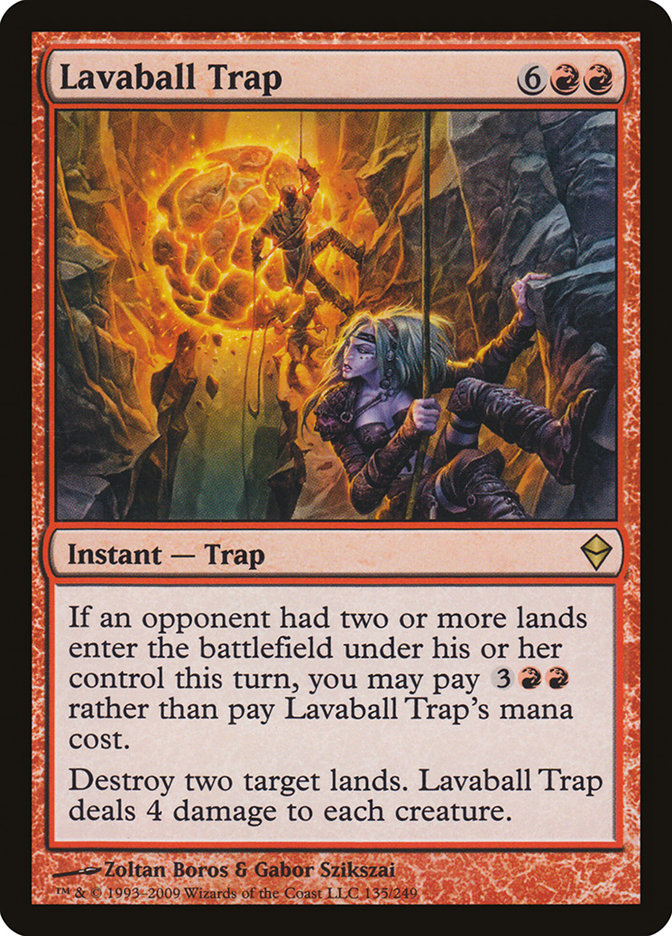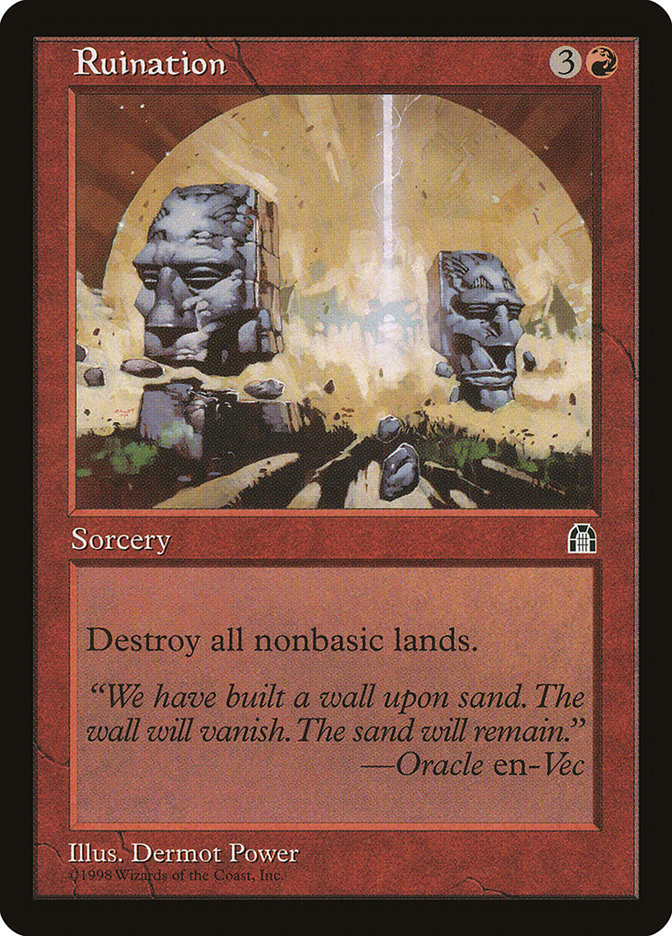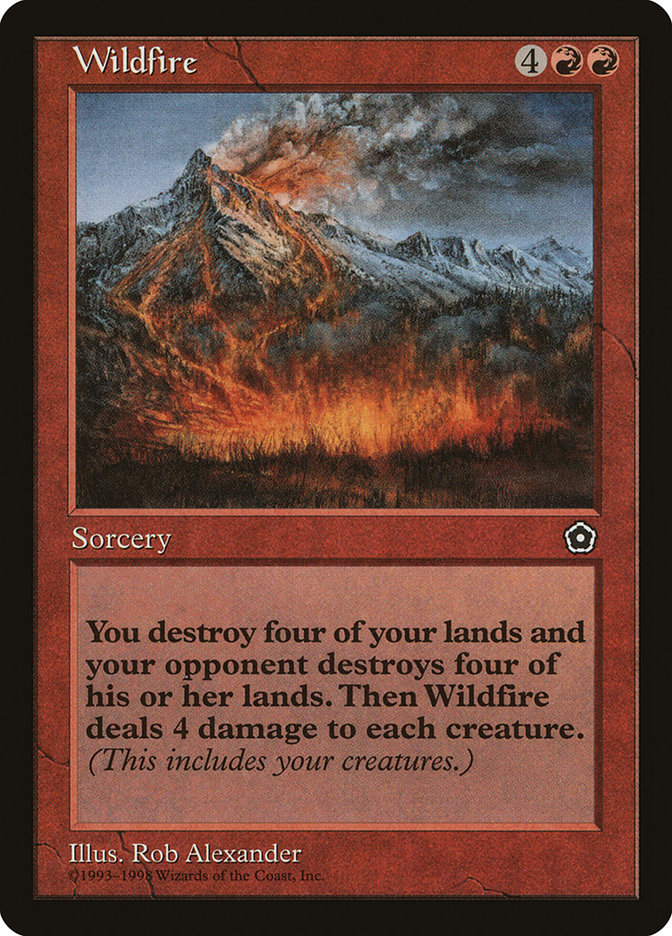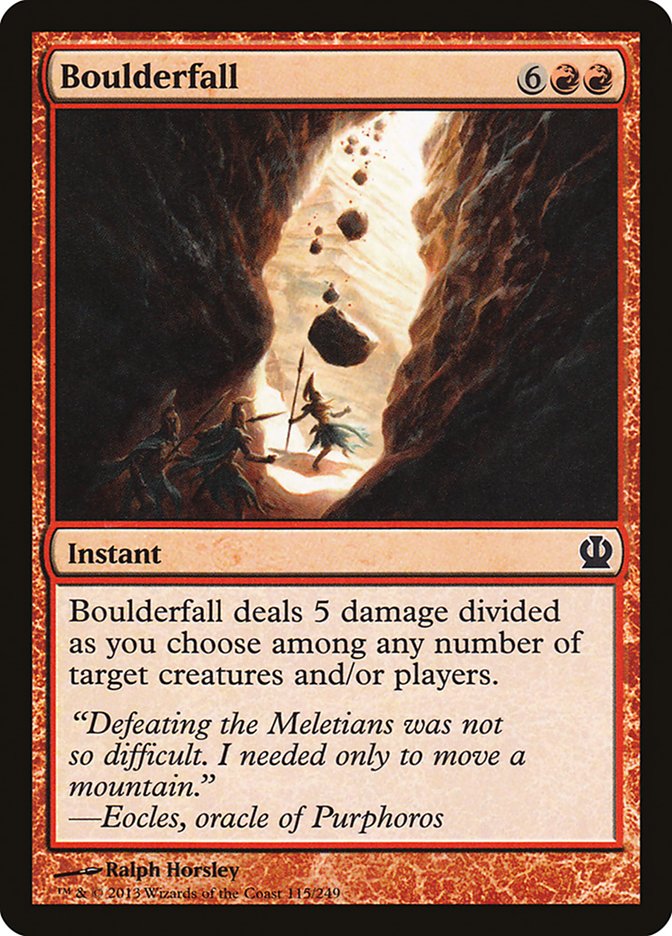Trampa bola de lava Carta MTG
| El coste de maná | |
| Costo de maná convertido | 8 |
| Rareza | Extraña |
| Tipo | Instantáneo — Trampa |
| Liberado | 2009-10-02 |
| Coleccione símbolo | |
| Coleccione nombre | Zendikar |
| Coleccione código | ZEN |
| Número | 135 |
| Frame | 2003 |
| Disposición | Normal |
| Border | Negra |
| Ilustrado por | Zoltan Boros & Gabor Szikszai |
Texto de la carta
Si un oponente tuvo dos o más tierras que entraron al campo de batalla bajo su control este turno, puedes pagar {3}{R}{R} en lugar de pagar el coste de maná de la Trampa bola de lava. Destruye dos tierras objetivo. La Trampa bola de lava hace 4 puntos de daño a cada criatura.
Cartas Similares
Lavaball Trap ofrece una mezcla distintiva de eliminación y disruptura de tierras dentro de MTG, recordando a cartas como Ruination. Mientras Ruination destruye todas las tierras que no son básicas, Lavaball Trap selecciona dos tierras y tiene la ventaja añadida de barrer criaturas más pequeñas. Sin embargo, viene con un coste de mana elevado que se mitiga bajo condiciones específicas. En comparación, encontramos Wildfire que no solo arrasa tierras, sino que también daña a cada criatura. Wildfire, aunque menos condicional, afecta a todos los jugadores por igual y no ofrece la reducción de coste potencial de la trampa.
Otra carta que comparte el tema de la destrucción de tierras es Volcanic Offering. Al igual que Lavaball Trap, proporciona la capacidad de retrasar las bases de mana de los oponentes. Sin embargo, Volcanic Offering ofrece más flexibilidad, permitiendo la destrucción de permanentes que no sean tierras y presentando interacción a velocidad instantánea manteniéndose independiente de las acciones de los oponentes. Por otro lado, Craterize se sitúa en un lugar más simple, destruyendo de forma directa una única tierra sin efectos adicionales, pero tiene la ventaja de un coste menor y más accesible que Lavaball Trap.
A medida que los jugadores evalúan sus opciones de control rojo, Lavaball Trap destaca por su potencial para un estilo de juego reactivo y un impacto significativo en la mesa, asumiendo que la preparación sea la adecuada. Es una inclusión importante en mazos que tienen como objetivo obstaculizar las estrategias de los oponentes a través del control de tierras y criaturas.
Cartas similares a Trampa bola de lava por color, tipo y coste de maná
Aspectos positivos de la carta
Ventaja de cartas: La Trampa de Bola de Lava ofrece un enfoque único para obtener ventaja de cartas. Aunque no te permite robar cartas directamente, la capacidad de potencialmente barrer múltiples permanentes del oponente con un solo hechizo puede cambiar el impulso del juego y reducir efectivamente los recursos a disposición de tu oponente. Proporciona una forma distinta de ventaja de cartas al perturbar la calidad del campo de tu oponente en lugar de la cantidad en tu mano.
Aceleración de recursos: La Trampa de Bola de Lava puede actuar como una fuente indirecta de aceleración de recursos. Al retrasar a tu oponente varios turnos y eliminar tierras o permanentes críticos, obtienes un aumento relativo de recursos en comparación con tu oponente. Esto te da el tiempo necesario para desarrollar tu tablero y superar al oponente en los turnos siguientes.
Velocidad instantánea: Una de las fortalezas de la Trampa de Bola de Lava es su capacidad para lanzarse a velocidad instantánea. Esta característica permite a los jugadores esperar el momento óptimo para perturbar las estrategias del oponente o responder a una amenaza abrumadora, todo sin comprometer la capacidad del jugador para actuar durante su propio turno. Reaccionar a los movimientos de tu oponente al final de su turno puede otorgarte una ventaja considerable, convirtiendo a la Trampa de Bola de Lava en una herramienta versátil en el arsenal de cualquier controlador rojo.
Aspectos negativos de la carta
Requisito de descarte: Un aspecto pasado por alto de la carta de la Trampa de Bola de Lava es la dependencia de que un jugador oponente haya activado una habilidad de tierra. Si esta condición no se cumple, te quedas con una carta que no se puede utilizar a su máximo potencial, retrasando así tu estrategia de juego.
Costo de maná específico: Al requerir una gran cantidad de maná rojo, la Trampa de Bola de Lava puede ser difícil de lanzar, especialmente en mazos que diversifican su base de maná. Para jugadores que no ejecutan un mazo monocolor o con inclinación fuerte hacia el rojo, esta carta puede permanecer inactiva, esperando la combinación correcta de maná para entrar en juego.
Costo de maná comparativamente alto: Con un coste de lanzamiento que incluye seis manás, dos de los cuales deben ser rojos, la Trampa de Bola de Lava es costosa. Especialmente en un formato donde la velocidad puede ser crítica, la inversión no siempre está justificada, dado que existen alternativas con costes de lanzamiento más bajos o impactos más inmediatos en el juego.
Razones para incluir en tu colección
Versatilidad: La Trampa de Bola de Lava ofrece una presencia disruptiva en cualquier mazo rojo centrado en controlar el tablero. Su capacidad para no solo infligir daño, sino también devolver tierras a la mano del oponente te da una ventaja significativa contra estrategias multicolores o de alta maná.
Potencial de combo: Integrándose con efectos de destrucción de tierra o de rebote, la Trampa de Bola de Lava tiene sinergia en mazos que manipulan el recuento de tierras. Activar su coste más bajo se vuelve más fácil, allanando el camino para combos devastadores que retrasan considerablemente a tu oponente.
Relevancia meta: Dado que los jugadores a menudo emplean numerosas tierras no básicas para afinar sus bases de maná, la Trampa de Bola de Lava gana relevancia. Compite bien contra mazos que dependen de esas tierras, obstaculizando o incluso interrumpiendo jugadas clave en la escena competitiva actual.
Cómo vencer a la Trampa de Bola de Lava
Lidiar con la Trampa de Bola de Lava requiere comprender sus condiciones de activación en Magic: The Gathering. Principalmente, se activa si un oponente hace entrar en juego dos o más tierras bajo su control en un solo turno. La clave para contrarrestar esto es regular tus jugadas de tierra o utilizar hechizos de destrucción de tierra a velocidad instantánea después de que se cumplan las condiciones de la Trampa de Bola de Lava para hacer más difícil lanzarla debido a su alto coste de maná. Además, la contramagia puede negar eficazmente esta estratagema roja, protegiendo tu base de tierras de ser diezmada.
Los jugadores también deben considerar reducir el número de tierras no básicas, ya que la Trampa de Bola de Lava se dirige específicamente a esas. Al centrarse más en tierras básicas, se minimiza el impacto de la Trampa de Bola de Lava. Además, mantener maná disponible para habilidades o hechizos que puedan contrarrestar hechizos destructivos ayuda a mantener un estado de tablero seguro contra esta trampa. Se debe prestar especial atención a conservar recursos para poder costear las contramedidas cuando amenazas como la Trampa de Bola de Lava se acerquen.
En última instancia, navegar estratégicamente en la ubicación de tierras, mantenerse proactivo con respuestas y una gestión cuidadosa del maná puede ayudar a mitigar la amenaza de la Trampa de Bola de Lava, preservando tus valiosas tierras durante las intensas partidas de Magic: The Gathering.
Donde comprar
Si estás buscando comprar una carta MTG Trampa bola de lava de un coleccione específico como Zendikar, existen varias opciones confiables que debes considerar. Una de las fuentes principales es tu tienda de juegos local, donde a menudo puedes encontrar paquetes de refuerzo, cartas individuales y mazos preconstruidos de colecciones actuales y pasadas. A menudo ofrecen el beneficio adicional de una comunidad donde puedes intercambiar con otros jugadores.
Para un inventario más amplio, particularmente de colecciones más antiguos, mercados en línea como TCGPlayer, Card Kingdom y Card Market ofrecen amplias selecciones y te permiten buscar cartas de colecciones específicos. Las plataformas de comercio electrónico más grandes como eBay y Amazon también tienen listados de varios vendedores, lo que puede ser un buen lugar para buscar productos sellados y hallazgos raros.
Además, el sitio oficial de Magic suele tener un localizador de tiendas y listas de minoristas para encontrar Wizards of the Productos con licencia costera. Recuerde comprobar la autenticidad y el estado de las cartas al comprarlas, especialmente a vendedores individuales en mercados más grandes.
A continuación se muestra una lista de algunos sitios web de tiendas donde puede comprar las Trampa bola de lava y otras cartas MTG:
 COMPRAR
COMPRAR BurnMana es un socio oficial de TCGPlayer
- eBay
- Card Kingdom
- Card Market
- Star City Games
- CoolStuffInc
- MTG Mint Card
- Hareruya
- Troll and Toad
- ABU Games
- Card Hoarder Magic Online
- MTGO Traders Magic Online
Ver productos MTG
Legalidades
Formatos de Magic the Gathering donde Trampa bola de lava tiene restricciones
| Formato | Legalidad |
|---|---|
| Commander | Legal |
| Legacy | Legal |
| Modern | Legal |
| Oathbreaker | Legal |
| Vintage | Legal |
| Duel | Legal |
| Predh | Legal |
| Penny | Legal |
Reglas e información
La guía de referencia para las reglas de las cartas Trampa bola de lava de Magic: The Gathering proporciona las reglas oficiales, las erratas emitidas, así como un registro de todas las modificaciones funcionales que se han producido.
| Fecha | Texto |
|---|---|
| 01/10/2009 | Todas las criaturas reciben daño, no solo las controladas por el/los controlador(es) de las tierras objetivo. |
| 01/10/2009 | Lanzar una Trampa pagando su costo alternativo no cambia su costo de maná o su costo de maná convertido. La única diferencia es el costo que realmente pagas. |
| 01/10/2009 | Los efectos que aumenten o reduzcan el costo de lanzar una Trampa se aplicarán al costo que elijas pagar. |
| 01/10/2009 | Si tanto las tierras seleccionadas como objetivo son ilegales en el momento en que Lavaball Trap se resuelve, el hechizo completo no se resuelve. Ninguna criatura recibe daño. |
| 01/10/2009 | Puede ignorar la condición del costo alternativo de una Trampa y simplemente lanzarla por su costo de mana normal. Esto es válido incluso si se ha cumplido la condición del costo alternativo. |
| 01/10/2009 | Puedes elegir dos tierras, no solo aquellas que entraron al campo de batalla en este turno. |







